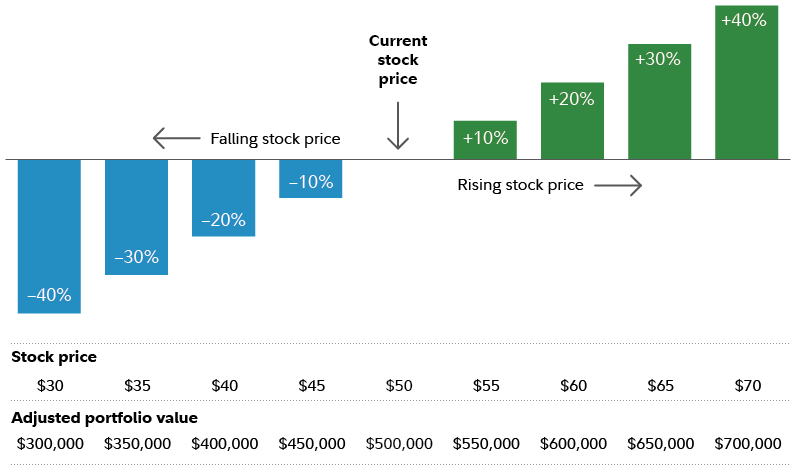Having too much of a good thing can be dangerous, particularly when it comes to company stock. Equity compensation has the potential to build wealth. But restricted stock, stock options, and other company stock plans can also lead to unintended concentrations in your portfolio—and heightened volatility. But there are strategies you can use to manage that risk, and navigate the taxes and rules that come with company stock.
"Many employees with equity compensation plans don't understand just how much of their wealth is concentrated in company stock or the risk it poses to their portfolio," says Chris Russo, vice president of executive benefits and compensation planning at Fidelity Investments. "Even companies that have produced a lot of wealth for an individual may run into trouble, and a concentrated portfolio, particularly one built on stock options, may be at risk for significant losses."
Concentration: Know what you own
Even if you've watched the value of your shares climb over time, there are good reasons to meet with a financial professional and discuss your stock exposure: Concentration can put your wealth at risk.
Investing in individual stocks typically carries higher volatility than investing in a diversified index because of diversification. That's particularly true for company stock, where your salary, deferred compensation, benefits, and investments may be tied to the same company.
That volatility could have big implications for the value of a stock portfolio. Consider the following hypothetical example, showing the impact of different price levels—both up and down—on a portfolio of 10,000 shares worth $500,000 total.

Steps to manage your company stock
If you have a large portion of your wealth in company stock, you may want to sell some of those shares and diversify your portfolio. Remember: The goal of diversification is not necessarily to boost performance, but to help manage risk. Since the rules that govern company stock grants and options can be complicated, some employees are limited in what shares they can sell or when they can sell them. And selling can come with big tax implications.
Fortunately, there are strategies you can use to help you manage risk. Here are 4 keys to unraveling concentrated positions while trying to minimize the tax hit.
1. Know how much is too much
Start with a plan for a mix of stocks, bonds, and cash, based on your timeline, risk tolerance, financial situation, and goals. Then consider how your company stock fits within that plan. Consider limiting any one stock or bond issuer (other than the US government) to no more than 5% of your stock or bond portfolio for a given goal, so say 5% of your retirement savings.
Many employees with company stock plans will have shares well beyond this threshold. And how much is right for you is a personal decision. Some investors have 15% to 20%. But before you sign off on such a large concentration, ask yourself how you would feel if that 15% to 20% were to drop sharply relative to the market overall.
2. Know what shares to sell when
If you do decide to get rid of some of your company stock, you will need to figure out which shares to keep and which to sell.
Beyond the plan rules that may limit what you can sell, taxes are a major factor. If you’re prioritizing minimizing taxes in the current year, look for shares with the least tax impact first. Two major factors beyond company outlook that might influence your choice of when to sell are tax impacts and plan rules. Option grants may have expiration dates in the near future which could impact the timing on when or what to sell.
The general rule when it comes to reducing taxes in the current year is to look for shares that would generate the least tax impact. There are some exceptions, for example, appreciated company stock shares held in a workplace plan may qualify for special tax treatment when you move them to a taxable account. This special rule for net unrealized appreciation may allow you to pay long-term capital gains taxes on the appreciation of shares held in your retirement account—but not if you’ve already sold them when you make withdrawals from the account. So if you have appreciated shares in a workplace plan, you may want to consider holding off on selling them.
Tip: Read Make the most of company stock
There are other reasons that could impact your strategy for which shares to sell, so you should consult your tax or financial professional before making any decisions.
3. Consider other ways to help reduce taxes
A next step is to think about strategies to manage the tax impact of selling shares from taxable accounts.
There are several options you can consider:
Gifting: Are you charitably inclined? When you donate appreciated securities that have been held for a year or more, you may be able to deduct the fair market value of the shares, and neither you nor the charity are required to pay capital gains taxes. That can boost the size of your donation and may help to reduce taxes. If you make charitable gifts anyway, this strategy may allow you to reduce your capital gains tax bill while decreasing your exposure to the stock. If you make the contribution to a donor advised fund, you could sell down your position now and take the tax deduction immediately, but choose to direct donations of the funds to charities in future years.
Staged selling: Instead of selling all your shares at once, consider breaking up the distributions into different tax years. The downside here is that you have to accept the risk of the position until you sell, but the upside is that it may spread out the tax payments or even manage your tax brackets.
Tax timing: You may want to talk to your financial professional about the best year for you to sell shares, particularly if you are approaching retirement or another event that could put you in a lower tax bracket.
Offset with losses: If you own securities that are worth less than they were when you bought them, you may be able to sell those and use those losses to offset the gains on your company stock (or leverage any losses you are carrying forward from previous years).
Saving opportunities: Contributions to IRAs, non-qualified deferred compensation, or workplace savings plans such as 401(k)s can potentially provide a tax deduction. Increasing your contributions in years when you sell company stock might help you manage your overall tax situation.
4. Manage remaining stock holistically
Even with active measures to reduce your risk, you will likely maintain a significant exposure to your employer as well as to the industry of which it is a part, both in terms of your investments and your compensation. You may want to factor that exposure into your overall portfolio design. For instance, if you work for a biotech company, and, in particular, if you have large exposures to your employer's stock from options, restricted shares, or other forms of non-cash compensation, you may want your investment portfolio to be underweight the biotech industry and/or health care sector. Your financial professional may be able to help with this and/or other strategies that manage the risk of a concentrated position.
Strategies for future shares
Once you have a strategy in place for your existing positions, you may also want to think about how you approach future positions—so you don't end up back in the same place.
One strategy is the immediate selling of restricted or performance stock shares when they vest.
Each time you reach a distribution for your shares, you sell and reinvest in a diversified portfolio. That will prevent the buildup of a concentration in your portfolio. Some employees who are deemed to have material nonpublic information about their employers may be restricted from selling during certain periods, but some companies offer a 10b5-1 program. These programs may allow an individual to make preplanned sales of a specific number of shares, even during restricted windows when selling might otherwise be off limits.
The bottom line
Allowing too much of your wealth to become concentrated in shares of any one company, even a great employer with a stock plan, could put progress toward your goals at risk. If you decide to sell some shares, a financial professional can help you build a strategy to navigate the rules that apply to selling, and help to reduce taxes.


